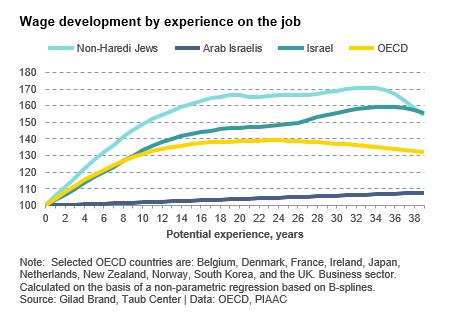This study focuses on workers identified in the OECD Survey of Adult Skills (PIAAC) as highly skilled and examines their employment characteristics, wages, and the degree to which they are employed in occupations demanding high skill levels.
Wage gaps between Israel and the OECD countries
The income of Israel’s highly-skilled workers is similar to the income of their counterparts in the other comparison countries, but the income of low-skilled workers is much lower than their peers.
- The average hourly wage gap between workers at the lowest skill levels in Israel and in selected OECD countries, as measured by PIAAC, reaches 50% while at higher skill levels it drops to only about 15%.
- The returns to skills in the upper part of the distribution are higher in Israel than in other countries, particularly among men: the gap between a worker with very high skills and a worker with lower skills is 33% among men and 27% among women – a rate almost twice as high as the gaps in the OECD (16% and 17%, respectively).
The characteristics of highly-skilled workers compared to low-skilled workers
The successful utilization of human capital for high-skilled workers in Israel points to the need to focus attention on low-skilled workers.
- About 95% of Israel’s higher-skilled, “exceptional” workers are non-Haredi (non-ultra-Orthodox) Jews – a sector that constitutes less than 70% of the total population.
- The skill level and level of formal education of the highest-skilled workers in Israel are not high relative to other OECD countries, yet it is evident that they are integrated into higher-wage jobs to a greater extent than outstanding workers in other countries among both men and women.
- The skill level of low-skilled workers is much lower than their counterparts in all other OECD countries (except Turkey and Chile), despite the fact that their education levels are relatively high.
- For the weaker half of workers, the return to academic studies is close to zero, an unusual finding in international comparison.
The Returns to Skill and Experience in the Arab Israeli Population
A particularly concerning picture emerges from the findings on returns to skills in the Arab Israeli population.
- While the Israeli labor market compensates Jews well for their skills, the Arab Israeli population is characterized by low returns to skill.
- Arab Israeli workers appear not to be remunerated in accordance with their experience: among non-Haredi Jews, each additional year of experience translates into an average wage increase of 2.5% (women) or 2.8% (men), while in the Arab Israeli sector the return amounts to only 0.1% (women) or 1.3% (men).


